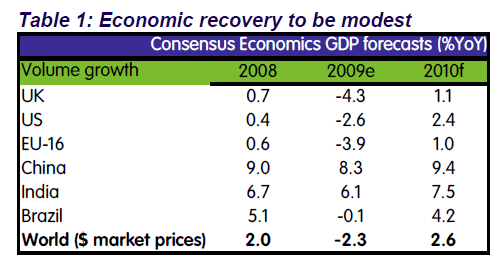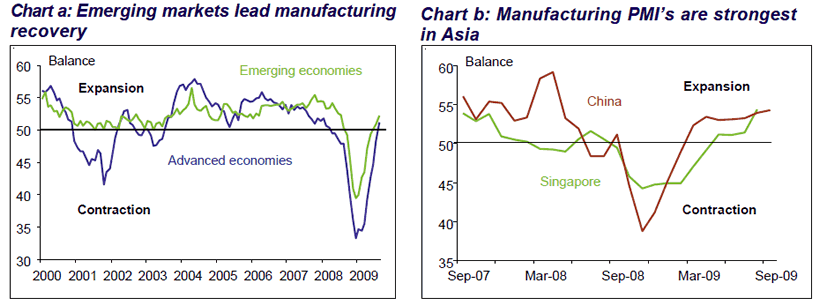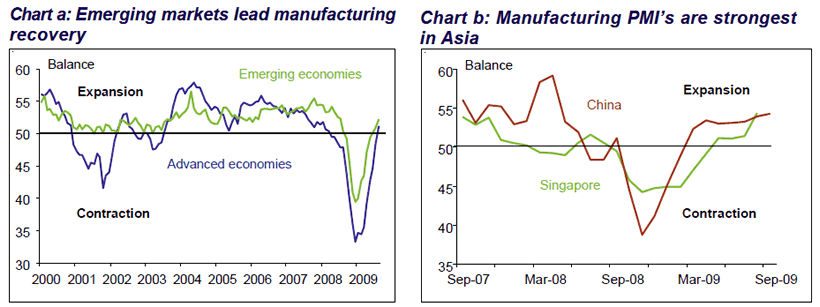Faltering World Economic Recovery?
Economics / Global Economy Oct 05, 2009 - 02:59 AM GMTBy: Lloyds_TSB
 It would be nice and easy to believe that the road to economic recovery is now clear and straightforward after the financial market crash of 2007-2009. Equity markets have had one of the best quarters ever, corporate and government bond yields have fallen sharply and spreads, in cash and corporate bonds, are narrower than at any time since the crisis gathered momentum in 2008. Economic growth has resumed in Q2 or Q3 of 2009 for most economies after a year of declines. Housing markets (US, UK, Spain, Ireland) are seeing a flattening in activity after the sharp falls of the past year or some modest up-tick. And manufacturing output is recovering from its lows in most countries. But there are some signs that the pace of the recovery is losing momentum and faltering. We look at some of these issues in this Weekly Report, starting with recent trends in financial markets.
It would be nice and easy to believe that the road to economic recovery is now clear and straightforward after the financial market crash of 2007-2009. Equity markets have had one of the best quarters ever, corporate and government bond yields have fallen sharply and spreads, in cash and corporate bonds, are narrower than at any time since the crisis gathered momentum in 2008. Economic growth has resumed in Q2 or Q3 of 2009 for most economies after a year of declines. Housing markets (US, UK, Spain, Ireland) are seeing a flattening in activity after the sharp falls of the past year or some modest up-tick. And manufacturing output is recovering from its lows in most countries. But there are some signs that the pace of the recovery is losing momentum and faltering. We look at some of these issues in this Weekly Report, starting with recent trends in financial markets.
 How sustainable is the recovery in financial markets?
How sustainable is the recovery in financial markets?
Financial markets have recovered but remain supported by record low interest rates and by money market operations of central banks that are offering liquidity virtually free. This is allowing banks to recapitalise, as lending spreads are still wide. Balance sheet restructuring is therefore going on – that is to say, reduction of liabilities and raising of new capital (some via equity issuance or bond issuance into stronger markets) – but still appears to have some way to go. One way of assessing this is that not all of the institutions that received public sector injections of capital have yet been able to pay it back. In addition, credit conditions are improving for businesses but spreads are wider and conditions attached to loans are tougher than at any time over the last decade.
Of course, financial market conditions are infinitely better than they were six months or a year ago but a clear and unambiguous path to recovery is not yet assured. The true test for financial markets will come when public sector support starts to be withdrawn, and private flows of funds have to replace central bank capital. Looking at the recent trends in manufacturing and other economic activity, however, gives us reason to think that this process will not be smooth nor should be undertaken too soon.
What about the recovery in economic activity?
There have been some tentative signs in recent weeks that the global economic recovery may not be advancing quite as strongly as the financial markets have been expecting. In the US and UK, manufacturing purchasing managers’ indices (PMI) posted a surprise fall in September. The weakness of these reports lends weight to the worry that the pick-up in developed countries’ manufacturing activity in recent months may owe more to the inventory cycle - and a reflux from the deep destocking that has occurred - and temporary car sale inducements, rather than any underlying and as yet sustainable fundamental improvement in final demand from consumers. Admittedly, in the Eurozone the manufacturing PMI posted a slightly stronger-than-expected rise in September although, at 49.6, it remains below the 50.0 level separating expansion from contraction. In some ways, September’s weaker-than-expected PMI surveys are a useful reminder that ‘all that glitters may not be gold’ in the manufacturing sector. Having indicated modest expansion in July after five consecutive monthly improvements, the latest PMI surveys may be a reality check in terms of firms’ inventory cycle. We may well be over the worst of the economic downturn, but there is not yet a compelling case for stockbuilding given the ongoing fragility of demand.


Overall, the emerging economies PMIs are showing that the recovery in manufacturing output levels is more vigorous from a higher trough than in the developed economies, see chart a. Highlighting this point is chart b, showing that PMIs in China and Singapore are well above those of the global average. In contrast, the PMIs in the US, UK and euro area are below the global average, and are showing stabilisation in output (near 50) rather than that any sustained rise is underway (above 50). Even the PMIs for services in the developed economies are little better - suggesting stabilisation and modest expansions rather than strong upturns. Recovery is occurring from the very depressed levels that private sector demand for consumer durables, housing, stocks and capital fell to. However, our view is that the after-effects of the financial market crisis and a desire amongst households and businesses to reduce debt will keep the recovery below the rates of expansion observed after previous downturns. Indeed, this is shown in the history of US recoveries from recession, with the consensus suggestion that the recovery after this downturn will be the weakest of any recession since the 1970s downturn, see chart c. Hence, the path to recovery in the US economy in the second half of this year and next, will be modest and potentially volatile.
Latest US economic data not encouraging for the pace of global economic recovery next year…
Latest economic data from the US seem to back up the view that economic recovery remains fragile at best. There was a plethora of disappointing US economic data last week (ADP employment data, Chicago PMI, ISM manufacturing). Finally, the September payroll numbers were very weak, -263k in September, versus a consensus estimate of around -175k. The unemployment rate, meanwhile, rose to 9.8% (in line with consensus) from 9.7% in August. Average hourly earnings increased just 0.1% during September, softerthan- anticipated by the market, chiming with the Fed’s statement in September which referred to ‘sluggish income growth’. Labour market conditions typically lag the GDP cycle, suggesting that the US economy is likely to strengthen only gradually in 2010. But the table shows that the US will still be the best performing of the major economies. Only the emerging countries will exceed its rate of growth, modest though it may be. Unsurprisingly, higher unemployment is probably the single biggest threat to a revival in global consumer activity. In countries such as Germany, this adjustment could be particularly sharp because, to date, government wage subsidies have led to a slower pace of labour market deterioration compared with other countries, see chart d. In the US, the labour market adjustment has been faster, and so may be the economic recovery, but it is also more painful.
…suggesting that a loose policy stance well be in lace well into 2010
The IMF said in its October report that: “The policy stance in the advanced economies should continue to support demand until the recovery gains a much stronger foothold. Against this background there is ample room to maintain very low interest rates and maintain unconventional instruments to counter adverse feedback loops between the real and financial sectors……Discretionary fiscal stimulus should not be withdrawn too early”. We think that the response to this IMF statement can only be, ditto. The recent good news has been a function of an inventory swing, better financial market conditions and the effects of fiscal stability programmes. Recent evidence suggests that it would be too soon to start withdrawing these measures now. This means that interest rates will remain low well into 2010, and that quantitative easing and other central bank support to financial markets will also be required.
Trevor Williams, Chief Economist, Corporate Markets
For more information: Emile Abu-Shakra Manager, Media Relations Lloyds TSB Group Media Relations Tel 020 7356 1878 http://www.lloydstsbcorporatemarkets.com/
Lloyds TSB Archive |
© 2005-2022 http://www.MarketOracle.co.uk - The Market Oracle is a FREE Daily Financial Markets Analysis & Forecasting online publication.



